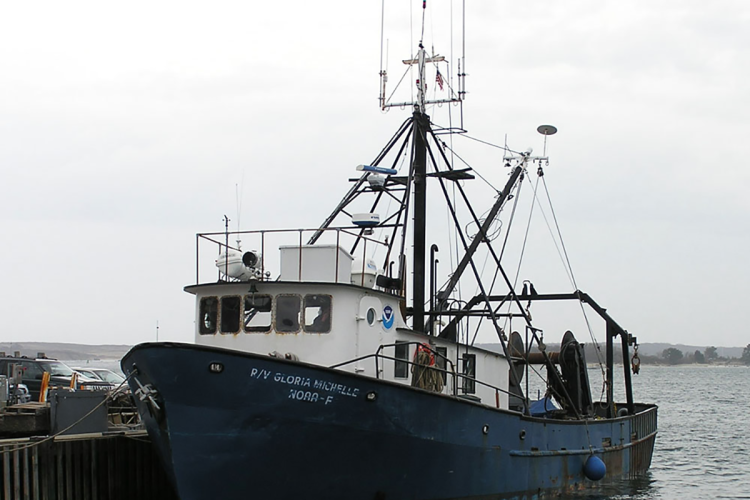New England Fisheries Science Center Research Vessel Has Colorful History
When not at sea, it is docked at the Northeast Fisheries Science Center’s Woods Hole Laboratory, where its current mission is far different than in its colorful past.
Netted in a Drug Case, Landed for Research Use
The steel-hulled vessel was built as a Gulf of Mexico shrimp boat by Diesel Shipbuilding of Jacksonville, Florida, in 1974, but in 1979 the ship was seized by U.S. Customs with a cargo of 16 tons of marijuana aboard stowed in the fish hold. After the trial for what was then the largest drug bust in Mississippi’s history, the vessel was mothballed at a backwater bayou near Biloxi, Mississippi, its fate uncertain.
Jack Moakley, then a lieutenant (jg) in the NOAA Commissioned Officer Corps assigned to the Conservation Engineering Group at the National Marine Fisheries Service laboratory in Gloucester, Massachusetts, recognized its potential as a modern research platform. At that time, Moakley was captain of the lab’s nearly 40-year-old former Army harbor tug Rorqual, and was looking for a more modern vessel to use for gear design, testing and scientific studies. He came across the Gloria Michelle on a federal surplus property list and contacted Customs, the General Services Administration and the U.S. Attorney in Louisiana to inquire about the vessel’s availability and its suitability for research in the Northeast.
After a lot of paperwork and phone calls, several trips to Mississippi and payment of $4,000 in storage fees, Moakley’s persistence paid off. The vessel was released to NOAA Fisheries and the Gloucester lab. After cleaning it up a bit and repainting green and white over its original powder blue, he and a crew sailed the vessel north to New England for refurbishment before it began its new (and legitimate) career. Moakley served as its first NOAA captain.

Conversion and Redemption
Unlike the Rorqual, the Gloria Michelle was built as a fishing boat. It had a refrigerated fish hold, a much larger deck area suitable for research, and nearly twice the horsepower. Although it required extensive modifications and upgrades to function as a research vessel, the Gloria Michelle was a welcome and much needed replacement for the aging Rorqual, which was sold at public auction.
While many things on the vessel have changed, one thing, however, remains the same. It was decided to keep Gloria Michelle as the vessel’s name. Moakley says that while other names were considered, the original name seemed to best suit the vessel. Also, if you are the superstitious sort, it is sometimes bad luck to change the name.
In its early years of service for NOAA, the ship was home ported in Gloucester, Massachusetts and used for cooperative experiments and testing scallop dredges, beam trawls and groundfish nets to help reduce bycatch. When the Conservation Engineering group was transferred to the Center’s Narragansett Laboratory in Rhode Island in the mid-1980s, the Gloria Michelle and her crew went with it.
A few years later, the Gloria Michelle was transferred to the Center’s new lab in Sandy Hook, New Jersey, where it spent some time in the early 1990s before finding a permanent home at the Woods Hole Laboratory.
What's She Like Today?
Now painted deep blue with a white deckhouse and equipped with an articulated crane to deploy and recover equipment, the Gloria Michelle has been extensively modified and upgraded through the years to the point where only its hull and name remain original.
The vessel is powered by a Caterpillar main engine which uses biodiesel fuel and has a single, fixed pitch propeller. Gloria Michelle operates in the coastal waters from Virginia to Canada, usually spending no more than five days at a time at sea. Two commissioned NOAA Corp officers run the boat. They will bring on additional deck hands as safety and operational parameters dictate. Eight passengers can make overnight trips, and up to 14 can make day trips.
Gloria Michelle Missions
Typical cruises include groundfish surveys in the spring and fall for the Massachusetts Division of Marine Fisheries, and a summer Gulf of Maine shrimp survey.
The groundfish surveys, which began in 1982, are each three weeks long. A crew of three to four vessel hands and four or five scientists work day trips seven days a week until the cruise objectives have been accomplished.
The Gulf of Maine shrimp survey is conducted in July and August over a four-week period. Ten crew and scientists embark for five days at a time for the survey, which is conducted by the Northeast Fisheries Science Center in cooperation with the Atlantic States Marine Fisheries Commission.

Special projects make up the rest of the ship’s operating schedule, which usually runs between April and October. Maintenance, repairs, upgrades and planning for future work are performed whenever the vessel is not conducting operations. These projects range from deploying a wave data buoy in Rhode Island Sound for the U.S. Army Corp of Engineers and multi-beam sonar mapping, to testing new technology, recovering equipment lost by other vessels, and conducting photo identification of marine mammals.
In 1994, the Gloria Michelle was used by the Food and Drug Administration to sample seafood in and around a toxic waste dumping ground in Massachusetts Bay. The seafood was found to be safe.
Notable Gloria Michelle Crew Members
Rear Admiral Jonathan Bailey, Director of the NOAA Corps and Director of the NOAA Office of Marine and Aviation Operations, sailed aboard the Gloria Michelle as captain during his sea-going career.
Jack Moakley went on to captain other, larger NOAA research vessels. As a civilian, he eventually became the Northeast's Chief of Operations and oversaw operation of Gloria Michelle, the ship that he secured and first helmed.
In 2012, NOAA Corps’ Lt. Anna-Liza Villard-Howe and Ensign Shannon Hefferan became NOAA’s first all-female ship’s crew, when Villard-Howe became the Gloria Michelle's captain and Hefferan the ship’s junior officer-in-charge.


